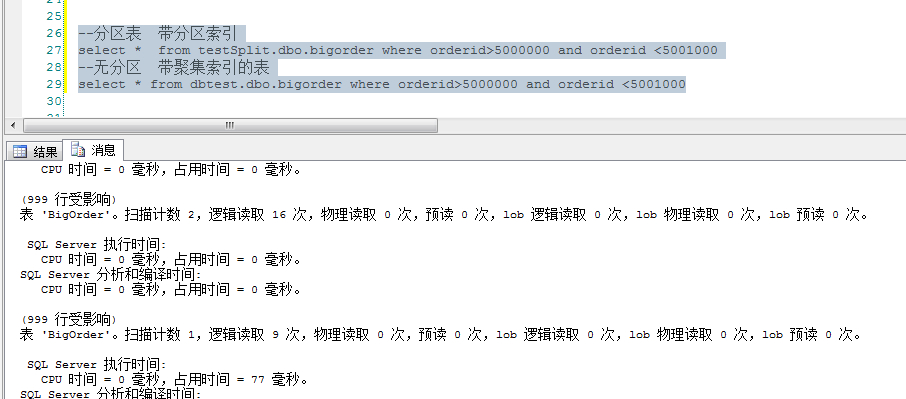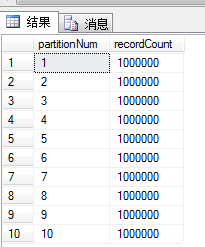SQL Server表分区
什么是表分区
一般情况下,我们建立数据库表时,表数据都存放在一个文件里。
但是如果是分区表的话,表数据就会按照你指定的规则分放到不同的文件里,把一个大的数据文件拆分为多个小文件,还可以把这些小文件放在不同的磁盘下由多个cpu进行处理。这样文件的大小随着拆分而减小,还得到硬件系统的加强,自然对我们操作数据是大大有利的。
所以大数据量的数据表,对分区的需要还是必要的,因为它可以提高select效率,还可以对历史数据经行区分存档等。但是数据量少的数据就不要凑这个热闹啦,因为表分区会对数据库产生不必要的开销,除啦性能还会增加实现对象的管理费用和复杂性。
跟着做,分区如此简单
先跟着做一个分区表(分为11个分区),去除神秘的面纱,然后咱们再逐一击破各个要点要害。
分区是要把一个表数据拆分为若干子集合,也就是把一个数据文件拆分到多个数据文件中,然而这些文件的存放可以依托一个文件组或这多个文件组,由于多个文件组可以提高数据库的访问并发量,还可以把不同的分区配置到不同的磁盘中提高效率,所以创建时建议分区跟文件组个数相同。
1.创建文件组
可以点击数据库属性在文件组里面添加
T-sql语法:
alter database <数据库名> add filegroup <文件组名>
---创建数据库文件组 alter database testSplit add filegroup ByIdGroup1 alter database testSplit add filegroup ByIdGroup2 alter database testSplit add filegroup ByIdGroup3 alter database testSplit add filegroup ByIdGroup4 alter database testSplit add filegroup ByIdGroup5 alter database testSplit add filegroup ByIdGroup6 alter database testSplit add filegroup ByIdGroup7 alter database testSplit add filegroup ByIdGroup8 alter database testSplit add filegroup ByIdGroup9 alter database testSplit add filegroup ByIdGroup10
2.创建数据文件到文件组里面
可以点击数据库属性在文件里面添加
T-sql语法:
alter database <数据库名称> add file <数据标识> to filegroup <文件组名称> --<数据标识> (name:文件名,fliename:物理路径文件名,size:文件初始大小kb/mb/gb/tb,filegrowth:文件自动增量kb/mb/gb/tb/%,maxsize:文件可以增加到的最大大小kb/mb/gb/tb/unlimited)
alter database testSplit add file (name=N'ById1',filename=N'J:\Work\数据库\data\ById1.ndf',size=5Mb,filegrowth=5mb) to filegroup ByIdGroup1 alter database testSplit add file (name=N'ById2',filename=N'J:\Work\数据库\data\ById2.ndf',size=5Mb,filegrowth=5mb) to filegroup ByIdGroup2 alter database testSplit add file (name=N'ById3',filename=N'J:\Work\数据库\data\ById3.ndf',size=5Mb,filegrowth=5mb) to filegroup ByIdGroup3 alter database testSplit add file (name=N'ById4',filename=N'J:\Work\数据库\data\ById4.ndf',size=5Mb,filegrowth=5mb) to filegroup ByIdGroup4 alter database testSplit add file (name=N'ById5',filename=N'J:\Work\数据库\data\ById5.ndf',size=5Mb,filegrowth=5mb) to filegroup ByIdGroup5 alter database testSplit add file (name=N'ById6',filename=N'J:\Work\数据库\data\ById6.ndf',size=5Mb,filegrowth=5mb) to filegroup ByIdGroup6 alter database testSplit add file (name=N'ById7',filename=N'J:\Work\数据库\data\ById7.ndf',size=5Mb,filegrowth=5mb) to filegroup ByIdGroup7 alter database testSplit add file (name=N'ById8',filename=N'J:\Work\数据库\data\ById8.ndf',size=5Mb,filegrowth=5mb) to filegroup ByIdGroup8 alter database testSplit add file (name=N'ById9',filename=N'J:\Work\数据库\data\ById9.ndf',size=5Mb,filegrowth=5mb) to filegroup ByIdGroup9 alter database testSplit add file (name=N'ById10',filename=N'J:\Work\数据库\data\ById10.ndf',size=5Mb,filegrowth=5mb) to filegroup ByIdGroup10
执行完成后,右键数据库看文件组跟文件里面是不是多出来啦这些文件组跟文件。
3.使用向导创建分区表
左边界右边界:就是把临界值划分给上一个分区还是下一个分区。一个小于号,一个小于等于号。
USE [testSplit] GO BEGIN TRANSACTION --创建分区函数 CREATE PARTITION FUNCTION [bgPartitionFun](int) AS RANGE LEFT FOR VALUES (N'1000000', N'2000000', N'3000000', N'4000000', N'5000000', N'6000000', N'7000000', N'8000000', N'9000000', N'10000000') --创建分区方案 CREATE PARTITION SCHEME [bgPartitionSchema] AS PARTITION [bgPartitionFun] TO ([PRIMARY], [ByIdGroup1], [ByIdGroup2], [ByIdGroup3], [ByIdGroup4], [ByIdGroup5], [ByIdGroup6], [ByIdGroup7], [ByIdGroup8], [ByIdGroup9], [ByIdGroup10]) --创建分区索引 CREATE CLUSTERED INDEX [ClusteredIndex_on_bgPartitionSchema_635342971076448165] ON [dbo].[BigOrder] ( [OrderId] )WITH (SORT_IN_TEMPDB = OFF, IGNORE_DUP_KEY = OFF, DROP_EXISTING = OFF, ONLINE = OFF) ON [bgPartitionSchema]([OrderId]) --删除分区索引 DROP INDEX [ClusteredIndex_on_bgPartitionSchema_635342971076448165] ON [dbo].[BigOrder] WITH ( ONLINE = OFF ) COMMIT TRANSACTION
执行上面的语句。分区完成。。
4.秀一下速度。
首先我在表中插入啦1千万行数据。给表分啦11个分区。前十个分区里面一个是100W条数据。。

可见反常现象,扫描次数跟逻辑读取次数都是无分区表的2倍之多,但查询速度却是快啦不少啊。
分区函数,分区方案,分区表,分区索引
1.分区函数
指定分依据区列(依据列唯一),分区数据范围规则,分区数量,然后将数据映射到一组分区上。
创建语法:
create partition function 分区函数名(<分区列类型>) as range [left/right] for values (每个分区的边界值,....)
--创建分区函数 CREATE PARTITION FUNCTION [bgPartitionFun](int) AS RANGE LEFT FOR VALUES (N'1000000', N'2000000', N'3000000', N'4000000', N'5000000', N'6000000', N'7000000', N'8000000', N'9000000', N'10000000')
然而,分区函数只定义了分区的方法,此方法具体用在哪个表的那一列上,则需要在创建表或索引是指定。
删除语法:
--删除分区语法 drop partition function <分区函数名>
--删除分区函数 bgPartitionFun drop partition function bgPartitionFun
需要注意的是,只有没有应用到分区方案中的分区函数才能被删除。
2.分区方案
指定分区对应的文件组。
创建语法:
--创建分区方案语法 create partition scheme <分区方案名称> as partition <分区函数名称> [all]to (文件组名称,....)
--创建分区方案,所有分区在一个组里面 CREATE PARTITION SCHEME [bgPartitionSchema] AS PARTITION [bgPartitionFun] TO ([ByIdGroup1], [ByIdGroup1], [ByIdGroup1], [ByIdGroup1], [ByIdGroup1], [ByIdGroup1], [ByIdGroup1], [ByIdGroup1], [ByIdGroup1], [ByIdGroup1], [ByIdGroup1])
分区函数必须关联分区方案才能有效,然而分区方案指定的文件组数量必须与分区数量一致,哪怕多个分区存放在一个文件组中。
删除语法:
--删除分区方案语法 drop partition scheme<分区方案名称>
--删除分区方案 bgPartitionSchema drop partition scheme bgPartitionSchema1
只有没有分区表,或索引使用该分区方案是,才能对其删除。
3.分区表
创建语法:
--创建分区表语法 create table <表名> ( <列定义> )on<分区方案名>(分区列名)
--创建分区表 create table BigOrder ( OrderId int identity, orderNum varchar(30) not null, OrderStatus int not null default 0, OrderPayStatus int not null default 0, UserId varchar(40) not null, CreateDate datetime null default getdate(), Mark nvarchar(300) null )on bgPartitionSchema(OrderId)
如果在表中创建主键或唯一索引,则分区依据列必须为该列。
4.分区索引
创建语法:
--创建分区索引语法 create <索引分类> index <索引名称> on <表名>(列名) on <分区方案名>(分区依据列名)
--创建分区索引 CREATE CLUSTERED INDEX [ClusteredIndex_on_bgPartitionSchema_635342971076448165] ON [dbo].[BigOrder] ( [OrderId] )WITH (SORT_IN_TEMPDB = OFF, IGNORE_DUP_KEY = OFF, DROP_EXISTING = OFF, ONLINE = OFF) ON [bgPartitionSchema]([OrderId])
使用分区索引查询,可以避免多个cpu操作多个磁盘时产生的冲突。
分区表明细信息
1.查看分区依据列的指定值所在的分区
--查询分区依据列为10000014的数据在哪个分区上 select $partition.bgPartitionFun(2000000) --返回值是2,表示此值存在第2个分区
2.查看分区表中,每个非空分区存在的行数
--查看分区表中,每个非空分区存在的行数 select $partition.bgPartitionFun(orderid) as partitionNum,count(*) as recordCount from bigorder group by $partition.bgPartitionFun(orderid)

3.查看指定分区中的数据记录
---查看指定分区中的数据记录 select * from bigorder where $partition.bgPartitionFun(orderid)=2
结果:数据从1000001开始到200W结束
分区的拆分与合并以及数据移动
1.拆分分区
在分区函数中新增一个边界值,即可将一个分区变为2个。
--分区拆分 alter partition function bgPartitionFun() split range(N'1500000') --将第二个分区拆为2个分区
注意:如果分区函数已经指定了分区方案,则分区数需要和分区方案中指定的文件组个数保持对应一致。
2.合并分区
与拆分分区相反,去除一个边界值即可。
--合并分区 alter partition function bgPartitionFun() merge range(N'1500000') --将第二第三分区合并
3.分区中的数据移动
你或许会遇到这样的需求,将普通表数据复制到分区表中,或者将分区表中的数据复制到普通表中。
那么移动数据这两个表,则必须满足下面的要求。
- 字段数量相同,对应位置的字段相同
- 相同位置的字段要有相同的属性,相同的类型。
- 两个表在一个文件组中
1.创建表时指定文件组
--创建表 create table <表名> ( <列定义> )on <文件组名>
2.从分区表中复制数据到普通表
--将bigorder分区表中的第一分区数据复制到普通表中 alter table bigorder switch partition 1 to <普通表名>
3.从普通标中复制数据到分区表中
这里要注意的是要先将分区表中的索引删除,即便普通表中存在跟分区表中相同的索引。
--将普通表中的数据复制到bigorder分区表中的第一分区 alter table <普通表名> switch to bigorder partition 1
分区视图
分区视图是先建立带有字段约束的相同表,而约束不同,例如,第一个表的id约束为0--100W,第二表为101万到200万.....依次类推。
创建完一系列的表之后,用union all 连接起来创建一个视图,这个视图就形成啦分区视同。
很简单的,这里我主要是说分区表,就不说分区视图啦。。






【推荐】国内首个AI IDE,深度理解中文开发场景,立即下载体验Trae
【推荐】编程新体验,更懂你的AI,立即体验豆包MarsCode编程助手
【推荐】抖音旗下AI助手豆包,你的智能百科全书,全免费不限次数
【推荐】轻量又高性能的 SSH 工具 IShell:AI 加持,快人一步
· AI与.NET技术实操系列:基于图像分类模型对图像进行分类
· go语言实现终端里的倒计时
· 如何编写易于单元测试的代码
· 10年+ .NET Coder 心语,封装的思维:从隐藏、稳定开始理解其本质意义
· .NET Core 中如何实现缓存的预热?
· 分享一个免费、快速、无限量使用的满血 DeepSeek R1 模型,支持深度思考和联网搜索!
· 基于 Docker 搭建 FRP 内网穿透开源项目(很简单哒)
· 25岁的心里话
· ollama系列01:轻松3步本地部署deepseek,普通电脑可用
· 按钮权限的设计及实现